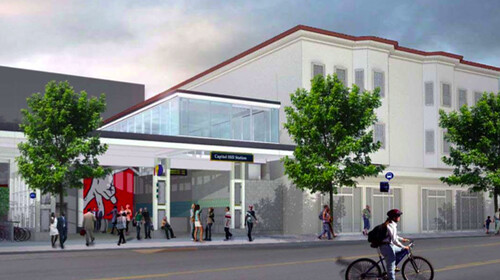
Wednesday night Sound Transit hosted a lively public discussion on Transit Oriented Development around the Capitol Hill light rail station. In an effort to dialogue with the community ST plans on hosting quarterly forums for people to share their thoughts and ideas about what should be developed around our future light rail station (dates TBD). If you missed the first meeting tonight, here’s a little recap of the evening’s events.
The meeting began with a short introduction about what we have to work with. As anyone who visits Broadway regularly knows, ST purchased about 3 acres of land that they will use to construct the new Link Station. While the land will be vacant during construction, the station entrances have been situated to take up as little space as possible, allowing for a significant amount of TOD land. The map below shows the four main TOD sites (blue) along with the three station entrances (red):
There seemed to be an unspoken understanding that the majority of the land would be developed as your typical, 6-story condo/apartment complexes springing up like dandelions here on the hill. But what ST wanted us to think about were the possible public amenities that could be incorporated into these new projects. In an effort to spark the crowd’s imagination, three speakers talked about what they envisioned on the site. First, Chris Curtis, director of the Neighborhood Farmers Market Alliance, spoke about the possiblity of a permanent home for the Broadway Farmers Market (which opens May 10th btw). She applauded its 35% increase in turnout last year and, along with some community members, suggested the possiblity of a bi-weekly or daily market because of the huge number of estimated vistors from light rail. Next, Michael Siewerath from Capitol Hill Housing, discussed adding more arts and culture space, lamenting the recent exodus of arts organizations from Capitol Hill. Finally, Capitol Hill Community Council President (and manager of this wonderful site), Justin Carder, talked about the idea of a more flexible community gathering space, where myriad clubs and organizations would be able to host their events, including the CH Community Council itself.
Along with these wonderful ideas, community members also had the opportunity to voice their thoughts about development. I was surprised and excited to find that instead of the usual banter over parking garages and height limits, the community seemed generally united in wanting to create a pedestrian oriented environment. Questions were asked such as, Could there be a maximum frontage size for retail spaces? Could the sidewalks be extended to over 20 feet? Could new buildings be required to be parking-less? The answer that Sound Transit gave was yes, all these things were possible….but it mostly depended on whether developers were willing to do these things on their own and if NGO’s could secure outside funding to help subsize these public benefits. In fact, according to Sound Transit, because of some vague concept of Fair Market Value and federal funding sources, they could really only suggest how development proceeded, not actually mandate what it looks like.
But pointed questions uncovered two key differences between this project and all previous Sound Transit stations. 1) Sound Transit purchased the land for the CH Light Rail Station instead of leased it, as they did on Beacon Hill, giving them substaintially more control over what development looks like and 2) The postion of the station at the heart of one of the most dense and dynamic neighborhoods makes the land around the station some of the most desirable in the city
The end of the meeting was summed up by one vocal community member who chastised Sound Transit for being too timid. As a public agency he said that it was paramount that Sound Transit prioritize the needs of the public. He called on Sound Transit to be aggressive and bold and to make sure that this once-in-a-lifetime opportunity truly transforms the way we think about transportation. Needless to say, he got a well deserved round of applause.




So if we want the farmer’s market to happen, what can we do to help?
It would be a travesty if space for the Farmer’s Market was not provided in the development, because it has become a vital source of “community” on Capitol Hill. However, the issue as to whether it will remain a once-a-week market (as it is now) or expand to other days is a critical one. I would love to see it there 7 days a week, ala the Pike Place Market, but I’m not sure that would be possible for most of the participating farmers….most of them are at other Seattle farmer’s markets on other days of the week. If it remains as a once-a-week market, the space would need to be carefully designed to allow other uses on the other 6 days.
Also, on the Google map, there seems to be a linear, north-south space between the 2 parts of the devlopment north of Denny. Is this just a gap between two buildings? Or is it an alley?….hope not, as this would invite all kinds of nefarious activity.
The space that looks like an alley on the map is actually a new extension of Nagle Place and the most likely new location for the farmers market. It looks narrow on the map but it will probably be the same width as Nagle place between Cal Anderson and the old Vivace. From the meeting it seems clear that this will one of the hot topics in terms of developing public space. At the moment it has potential to be a pretty and functional public space, or a blighted alley. The more creative ideas that can be brainstormed, the better.
I am now drooling over the idea of a 7 day a week Farmer’s Market on the Hill. Could we make it year-round too?
Thanks again for the great land use reporting, Josh :)